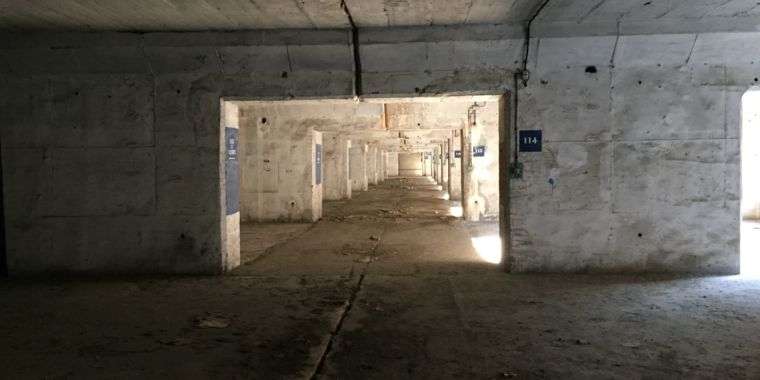
Why a former Nazi sub base in Marseille is becoming a data center

-
Fabrice Coquio, Managing Director of Interxion, at the site of MRS3—a data center being built in a former Nazi sub bunker.
-
The exterior of the U-boat bunker, in the midst of France’s biggest seaport, before construction began.
-
Inside, the cells of the sub bunker—originally intended to limit damage by Allied bombing—make for a pre-built, modular data-center layout.
-
Some nautical graffiti adorns the walls inside what will soon be MRS3.
-
An artist’s rendering of what the finished MRS3 data center will look like.
-
An artist’s rendering of MRS3 as it will look in Marseille’s national harbor complex.
-
The many, many submarine cable networks that MRS3 and the other Marseille data centers can tap into.
Marseille—France’s largest city on the Mediterranean coast—is many things. It’s the country’s largest commercial port, the birthplace of French hip-hop, and the home of the French Foreign Legion. It’s also a tech industry hotspot and the landing station for 13 major submarine cables. These cables connect Europe with North America, Africa, Cyprus, the Middle East, and Asia. Two more are scheduled to come online next year.
From a networking standpoint, the cables place Marseille very close to Cairo, Dubai, and Saudi Arabia. According to Fabrice Coquio (the managing director for France of data-center-operator Interxion), there are only five or six milliseconds of network latency to any of those locations—less than to Paris 800 kilometers (roughly 500 miles) away.
That has made Marseille a magnet for data-center operations—where data and application providers can “put platforms in a safe environment in terms of legal and financial environments like Europe and particularly the European Union and at the same time be connected to 46 countries directly with a very low latency,” Coqiuo explained. “Basically, in the last 15 years, we have [cut] the cost of a submarine cable to a [10th of what it was] and multiplied the capacity by 50.”
As a result of this transformation of the Internet world and the corresponding rise of Marseille as a digital content center for the world, demand for co-location space has driven Interxion to undertake an interesting construction project: the conversion of a former Nazi submarine base into a seaside data center.
Who’s the U-boat commander?
Netherlands-based Interxion already has one data center in Marseille (MRS1). The company acquired it in 2014 when it was only half-provisioned, and Internexion also had a second (MRS2) under construction nearby. But as Interxion’s managing director in France Fabrice Coquio explained, demand was so high for connectivity to the nearby cable landings that the company needed to start construction of a third data center in parallel with the second.
“Our customers could not depend on one building only, so most of them require a dual-site configuration for obvious purposes,” explained Coquio, “and that’s the reason why two years ago we started the works for MRS2.” The first phase of MRS2 was completed in May of 2018, and the site will be fully operational by the end of this July, with 4,300 square meters [about 46,000 square feet] of rack space. “But in parallel, we’ve got at the same time very large requirements from platforms in general and particularly cloud platforms.”
So Interxion started looking for a way to quickly build a third data center: MRS3.
And that’s where the sub base comes into play. Built by the Germans near the end of the Second World War, the U-boat bunker was never completed. A giant harborside concrete monolith, it had sat vacant for over 75 years—attracting graffiti artists and dust.
This sort of project is rare in the data-center business. “Usually, Interxion uses green fields, and then we build data centers according to whatever you can need,” Coquio said. But the immense size of the bunker complex and its location were an opportunity that has become a 140 million Euro (roughly $16 million) investment in itself. It takes advantage of the cellular construction of the U-boat bunker to build an expandable, modular data center.
“Cloud platforms and content platforms require not just hundreds of square meters of space,” Coquio said, “but multiples of megawatts of IT power.” While MRS1 and MRS2 are more about having a high network density, MRS3 will be focused on compute density, MRS3’s design allows for “compute rooms with the same kind of racks, the same kind of servers, and so on,” he noted, “and is going to be much more dedicated to cloud platforms and digital media platforms.”
Safe harbor
Physical security won’t be much of an issue with the bunker design. The bunker’s location within the national harbor area is also a plus: “It’s totally fenced, protected, protected by the national gendarmerie in France,” Coquio explained, “and in terms of security, this is also something which attracted some of our customers and particularly, by the way, some of our American customers.”
The proximity to the harbor also means MRS3 is being designed to deal with the elements, including seawater and salt corrosion. “There’s something more dangerous than the salt, and that’s all the micro-particles that you are getting from the diesel engines of the ships—whether you’re talking about cruise ships, or ferries, and so on,” Coquio said. “So that’s the reason why we’ve got very specific filters equipping our exhaust pipes for our generators, but also all the filters for the dry coolers or the chillers on the roof.”
While MRS3 won’t be complete until the end of the year, Interxion is already seeing a surge in customers using its Marseilles data centers as a staging and assembly plant for digital content.
“Approximately a year ago, we saw that a lot of companies were coming to our sites to use that as a kind of a manufacturing plant for content—cloud content, digital media content, social content, whatever,” Coquio said. “They aggregate the various parts coming from various parties and produce that as if it was a real factory. And from that factory, it’s not only a production plant—it’s also a distribution plant. And that’s what is really making Marseille unique here.”
The data centers are also drawing interest from customers at the other end of those cables. “We signed with a company from the Middle East which is basically a kind of a Arabic Netflix,” Coquio said, “and of course their scope is not as wide as the one of Netflix, but they still deliver video content to approximately more than 400 million people. They can collect and pull all the content from Marseille.”
Listing image by Interxion




